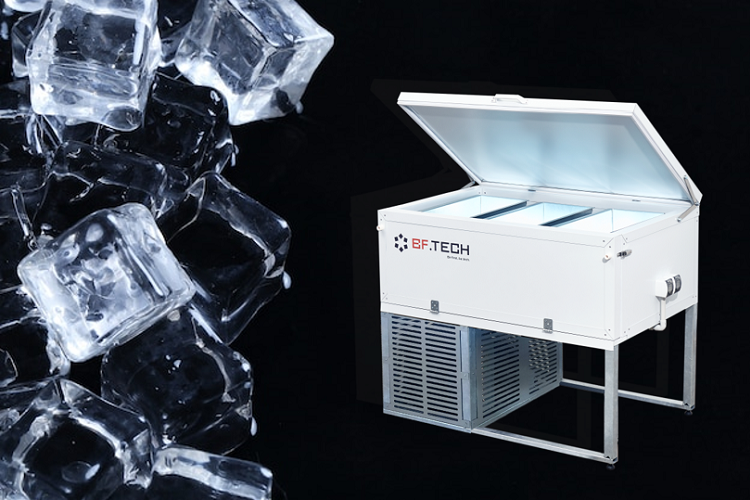There are many key factors to consider when choosing an ice maker for home. However, the choice depends primarily on how much money you will spend on the purchase of such a product.
Today, BF Tech offers many models of home ice generators, the prices of which can vary greatly. Do not rush to buy a block ice machine right away. It is important to understand the key differences between one model and another, understand your own needs, compare different models, and choose the right ice maker that meets your current needs and expectations.
First of all, consider the size and appearance of your ice maker. Sizes vary from model to model. Then set the type of ice you need and what your chosen ice maker should make.
Most of the present models create ice of certain shapes. One model is more expensive and makes ice cubes. Another model is cheaper, but it has a limited amount of ice production for a certain time.
There are different techniques for making ice. Therefore, there is a price difference. Home ice makers no longer need to connect a water source. This is usually a small device about the size of a microwave oven. A home ice maker makes ice faster than a traditional refrigerator. The cycle of making ice lasts 10-15 minutes. The duration depends on the size of the ice and the temperature of the water entering the device. Most ice makers freeze water in the form of cubes.
In addition to various forms, ice is made in granule form by industrial ice makers. There is also “flake” ice, which is indispensable for showcases with fresh fish.
Key features of a home ice maker
The main technical characteristics are as follows:
- Low power consumption;
- The maximum amount of ice an ice maker can make per day is limited;
- The volume of the ice container can be removable.
More advanced models of ice generators maintain the temperature in the device and prevent the ice from melting. The daily ice capacity of home ice makers is usually 10-20 kilograms. A home ice maker does not require a water supply.
When choosing a specific ice maker, learn more about the ice cube sizes you can choose from. Also, see how many cubes can be made in one ice-making cycle. Depending on the model, this number varies. It will not be superfluous to find out how long it takes to prepare certain volumes of ice. On some models of ice generators, the first cycle of ice production takes about 40-50 minutes, and the duration of subsequent cycles decreases.
This can be explained by the fact that the necessary temperature conditions must be created for further work inside the ice maker. The performance of the ice maker is a key indicator for many buyers. It should not be forgotten that this indicator is often overestimated compared to real conditions.
Ask how much ice you can get from the ice maker in a certain amount of time and how much water you need to put into the ice maker for that. There are many offers from different manufacturers. If you need an optimal model, you can easily choose an ice maker that meets your needs and current expectations.
An ice maker is an electric device for preparing a large amount of ice. Devices are installed in restaurants, bars, supermarkets, and some industrial enterprises. Cocktails and quick-chilling products are prepared from the ice made using it. This device is available in the market in different performance models. Automatic operation eliminates the need for constant supervision. This gives you access to an almost infinite amount of ice. The main thing is that the generator has time to freeze the water.
The process of making the amount of ice you need
There are many models of ice makers, but they all work according to the same principle. Inside the device is an evaporator, which is used in a regular refrigerator, which is in every kitchen.
A high-pressure pump directs water under pressure to the surface of the evaporator, freezing the liquid and forming ice. The hot steam is then directed to the ice through special technical openings, as a result of which the ice melts and falls out of the evaporator. All parts are sent to special bunkers, where they also maintain a low temperature and do not melt.
The devices are equipped with a special timer that activates the water pump and evaporator. There are also sensors to control the filling of the hopper with ice. The ice maker will restart its cycle when the tank is full of ice. Thanks to this, the device works completely automatically, you do not need to pay attention to checking each cycle.
Types of available ice makers according to the power criterion
According to performance, ice makers are divided into household and commercial ones. Household models of ice generators include equipment that is actively used in restaurants and bars. The capacity of this device does not exceed 100 kilograms of ice per day.
Industrial models of ice makers used in food factories can produce large amounts of ice. This amount is necessary for cooling various products. It is mainly used for storing fish on open shelves without putting it in the refrigerator.
Types of ice makers according to the water supply system
For the ice maker to work, it must be provided with clean drinking water. According to this key principle, devices are divided into two categories: ice generators for filling and ice generators that need to be connected to a source of water supply.
The basic type of ice maker connects to a regular system. Their design has a special valve that allows water to enter the device by opening the tap.
Automatic washing machines work according to this principle. Water is supplied from the water supply, so the device does not require human intervention. The main unit must be connected to the sewage network. They are usually self-cleaning by washing. If you activate this option, the device will remove ice accumulated in different places.
The filling-type ice maker has a special container that must be filled with water manually. This device is used where there is no access to tap water or where it is contaminated. This device stops the formation of ice when the tank is low on water, so it is necessary to check the water level regularly and top up if there is not enough water.
Some devices warn of a low fluid level with a sound or light signal. That way, you can focus on the problem at hand and not worry about not having ice when you need it.
Depending on the design, the ice maker can be placed on the floor or a table. Ground equipment of high quality. It can be equipped with a tank or connected to a separate tank. This increases performance by increasing the storage capacity. These models are usually stationary. They are attached to the water source and cannot be moved.
A tabletop ice maker is a model for small households. Some devices are built into bar counters. Such a device can be connected to the water supply or equipped with a special tank for manually filling it with water.




